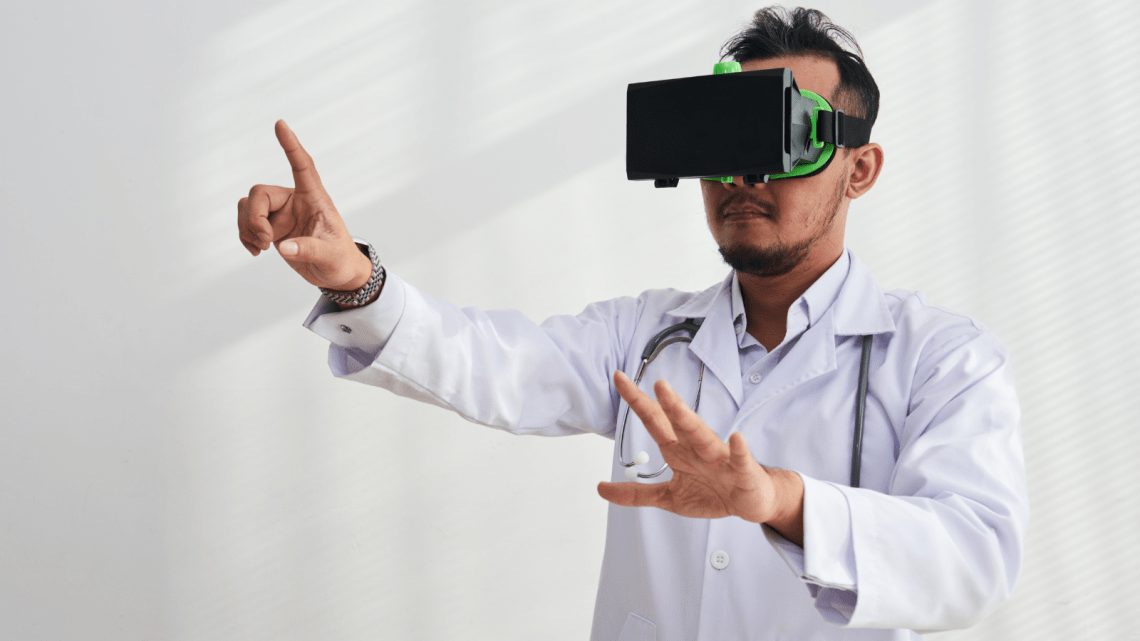
UBC CPD’s visiting professor, Dr. Vernon Curran, shares insight on the use of extended reality (XR) in medical education, considering the impact of XR in rural communities and ongoing continuing professional development.
Immersive technology in medical education
Extended reality (XR) is an umbrella term for existing immersive technology, including augmented reality (AR), virtual reality (VR) and mixed reality (MR). There are six simulation-based education types, including task trainers, human patient simulators, standardized patients, screen-based simulations, XR and hybrid simulations. XR is a new and emerging type of simulation-based learning technology in medical education. The different types of XR (e.g., VR, AR) enable different levels of immersive experiences across the virtual-reality continuum and offer exciting opportunities for use in medical education and training.
These learning technology systems involve the use of VR headsets to create entirely artificial computer-generated environments, AR headsets to overlay digital information on the image of a real-world environment and XR affordances, features that include the ability to exchange sensory input and allow the user to be fully immersed in an environment with image and sound.
Dr. Vernon Curran has been Associate Dean of Educational Development with the Faculty of Medicine, Memorial University since 2015 and is Professor of Medical Education with the Division of Population Health and Applied Health Sciences. He specializes in digital health and learning in medicine, simulation-based medical education, CME, CPD and more. Dr. Curran suggests that XR offers many potential benefits for medical education, such as allowing standardized learning experiences and more convenient access due to minimal equipment requirements. The emerging evidence also indicates that XR technologies can be just as effective as traditional learning techniques and methods and in some areas, lead to better learning outcomes.
Other ways in which XR can be used in medical education include the ability to:
- live-stream procedures to a lecture hall or mobile phone
- employ 3D point-of-view video recordings in teaching and instruction as tutorials with commentaries
- provide video recordings of learner performance with live or post-coaching feedback
- provide recordings of patients’ point of view
Testing immersive technology in rural medical training
To explore the effectiveness of XR in medical training, Dr. Curran’s research has included an exploratory qualitative study, examining health professionals' experiences with using VR 360 video for training updates in Pediatrics Advanced Life Support (PALS) and the Neonatal Resuscitation Program (NRP). This work has been published in: Curran, V., Xu, X., Simmons, K. et al. A phenomenological study of the use of 360° Virtual Reality (VR) video in pediatric and neonatal resuscitation training. Health Technol. 12, 151–159 (2022). DOI:10.1007/s12553-021-00615-w
His most recent research includes an action-research study where demonstrations of the XR technology take place across rural medical teaching sites to give health professionals an opportunity to use the technology. Interviews are being conducted after the demonstrations to better understand health professionals’ experience with the VR headsets and how this technology can be used for teaching and learning in rural communities and ongoing CPD.
Evaluating user experience with immersive technology
Dr. Curran has followed a phenomenological approach in his research, gathering insight from people’s experience with immersive technology, particularly at a CPD level and how it may be used to boost or maintain one’s knowledge and skills retention over time.
Dr. Curran’s team has been evaluating users’ experiences with both VR headsets and VR 360 video instruction in training, including observations and comparison of skills performance by health professionals, following the use of the technology.
Results found that although both technologies showed equal satisfaction and value, participants who used immersive VR technology, scored higher in training evaluations and reported higher confidence levels in Neonatal Resuscitation Program (NRP) skills (correct mask placement, ability to evaluate response after 30 seconds and more).
Application at UBC CPD
While UBC CPD doesn’t currently have XR-enabled CPD available, virtual simulations have been long popular — including webinars like Virtual Anatomy and Surgery Broadcasts for Engaging Medical Education. UBC CPD aims to explore how hands-on learning could be augmented through XR-enabled medical education.
The UBC CPD Research Working Group, with participation from Dr. Curran, continues to explore the latest technology for learning.